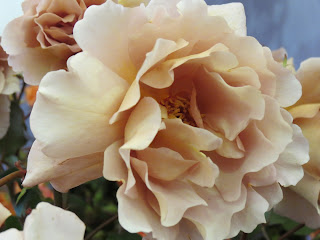 |
| Poppy: not white, but full of seeds, more usefully than you'd think |
Today it's been seeds. First I was researching a seedy subject for an article I was writing: saving seed from your best plants (always a good idea: you save money, you ensure you've got stocks of your favourite variety for next year, and if you do it over a number of years you end up with a strain uniquely adapted to your own conditions: a sort of micro-local heritage variety. What's not to like?).
In this case I was looking into how much better polytunnels are for isolating veg like carrots or chard which would otherwise cross-pollinate all over the place. My friend once ended up with pumpkin-butternuts because her cucurbits got busy and re-seeded the resulting mongrels all over her veg patch: quite tasty but very odd.
I digress. Just as I was putting the finishing touches on the finer points of cross-breeding calabrese, my daughter - on holiday therefore terminally indolent - called me in to see something she was watching on the telly.
It was indeed, as she emphatically informed me, epic: Neil Buchanan, failed rock star, Scouser, and hyper-bouncy presenter of the CITV series Art Attack (which almost - almost - reaches the heady heights of Vision On, and from me that is high praise indeed) was creating an enormous and finely detailed snake, twice his own height, out of poppy seeds. By the wonder that is video on demand, you can see the whole thing here (from 7 minutes in). Poppy seeds as art material. Who knew.
And that reminded me of the thing I was reading last night in this month's copy of The Garden: it was an absorbing and rather wonderful visit to the private garden created by Sybille Kreutzberger and the late Pamela Schwerdt, erstwhile head gardeners at Sissinghurst Castle.
The bit that stuck in my mind was their painstaking pursuit of the cultivars they regarded as the best possible selections. They fell in love with a white form of the opium poppy, Papaver somniferum, they saw in a picture taken in Afghanistan: it wasn't available in the UK, so they wrote to a bakery which decorated its bread with poppy seeds sourced there. The white poppy is now growing in the White Garden at Sissinghurst. Now that's what I call dedication.
And then just to round it all off, I reminded myself to sign up for Carl Legge's seedy penpals scheme: thanks go to Zoe for the timely blog post. I think seed-swapping penpals is quite the loveliest idea I've come across for a long time. I always have a few spare seed packets kicking about the place and can't think of anything nicer than sharing the love with someone (and hopefully getting some interesting bits & bobs I've never tried before in return).
I urge you to join in, if you haven't already: we could all do with a few more seeds in our lives.



















































